Note: This article contains affiliate links to Hema Maps & Camera House. If you click through and make a purchase, we earn a small commission at no extra cost to you.
The Old Eyre Highway was notorious. Mile after endless mile of choking dust, corrugations, huge bull dust holes and endless limestone rocks.
Ill-equipped cars being smashed to pieces on this epic journey across the bottom of Australia.
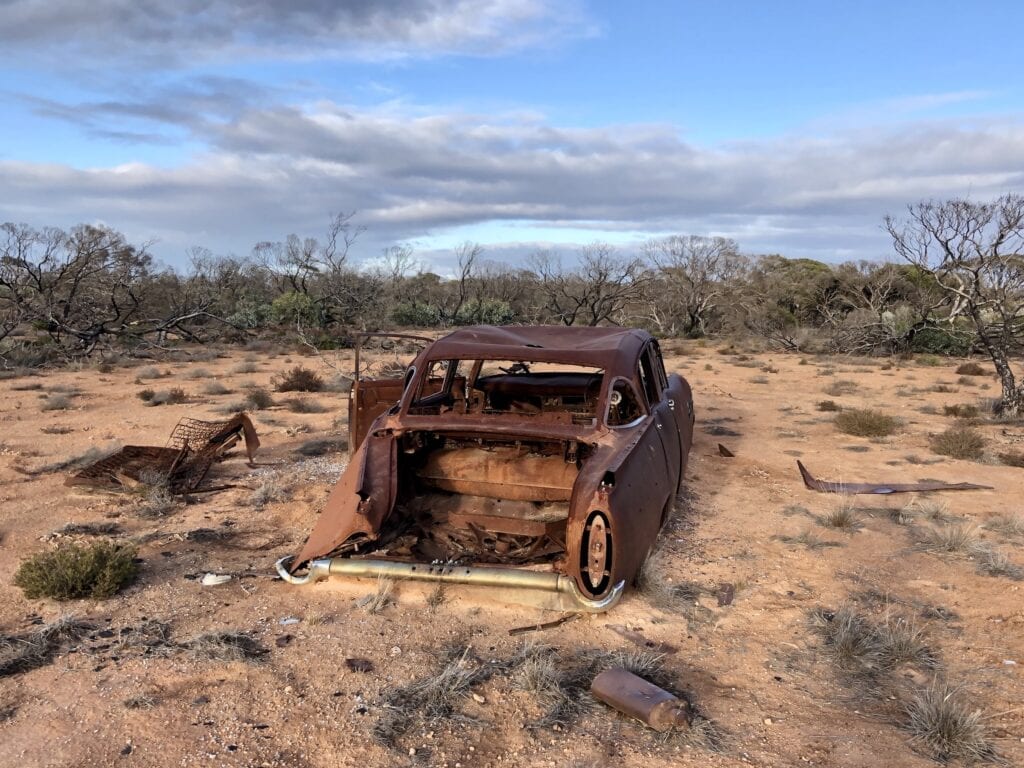
Massively overloaded, underpowered and infamously unreliable British trucks pounding their way along, stopping constantly to change shredded tyres or sometimes to rebuild a gearbox by the side of the road.
The Old Eyre was brutal. In summer, radiators boiled and tyres popped like balloons.
In winter, the rains would turn it into a sea of vehicle-sucking mud and freezing winds.
Nowadays, it’s difficult to imagine just how insanely challenging this road was. However, you can still get a glimpse of the past.
A Time Capsule
In fact, you can still drive along the Old Eyre Highway between Nullarbor Roadhouse and Border Village. We drove it west to east.
As soon as you cross the WA/SA border into South Australia from the west, turn left off the Eyre Highway into what looks like a dirt rest area. It’s directly opposite the roadhouse. Follow this for a few hundred metres and you’ll see the Old Eyre Highway in front of you.
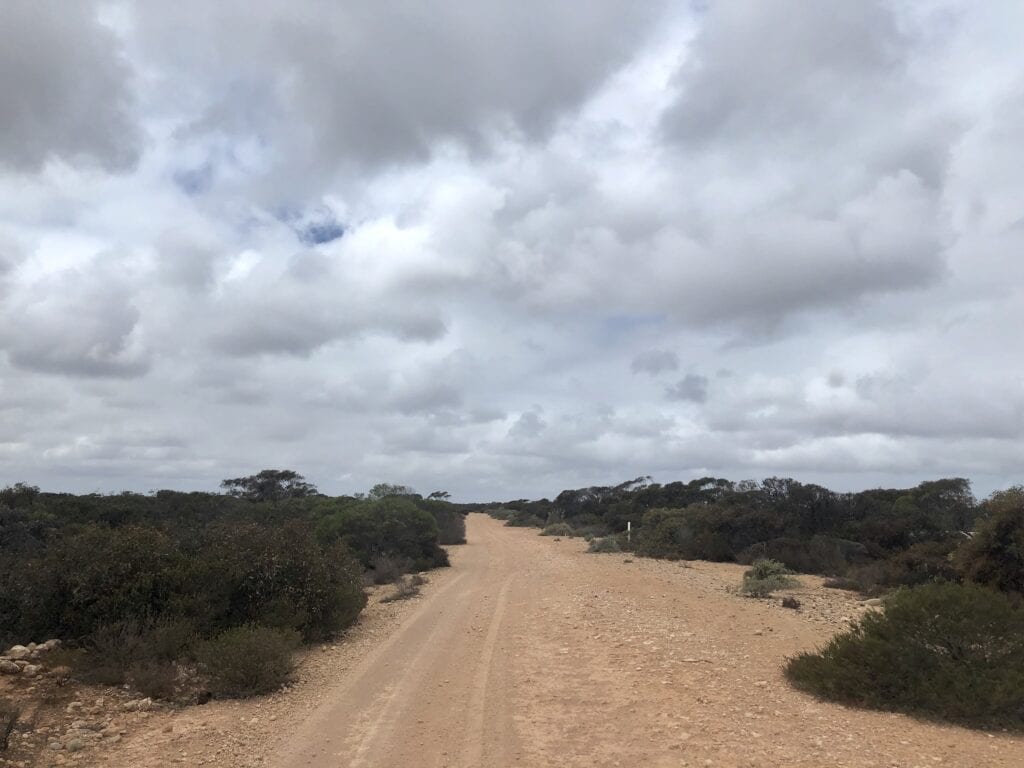
It’s overgrown now, with trees and shrubs growing out of the road. You can still drive it, you just have to dodge the trees!
The surface is rough and rocky, as you’d expect.
Reefs of limestone poke through the surface and there’re plenty of sharp limestone rocks waiting to damage your tyres. Just take it slowly and you’ll be fine.
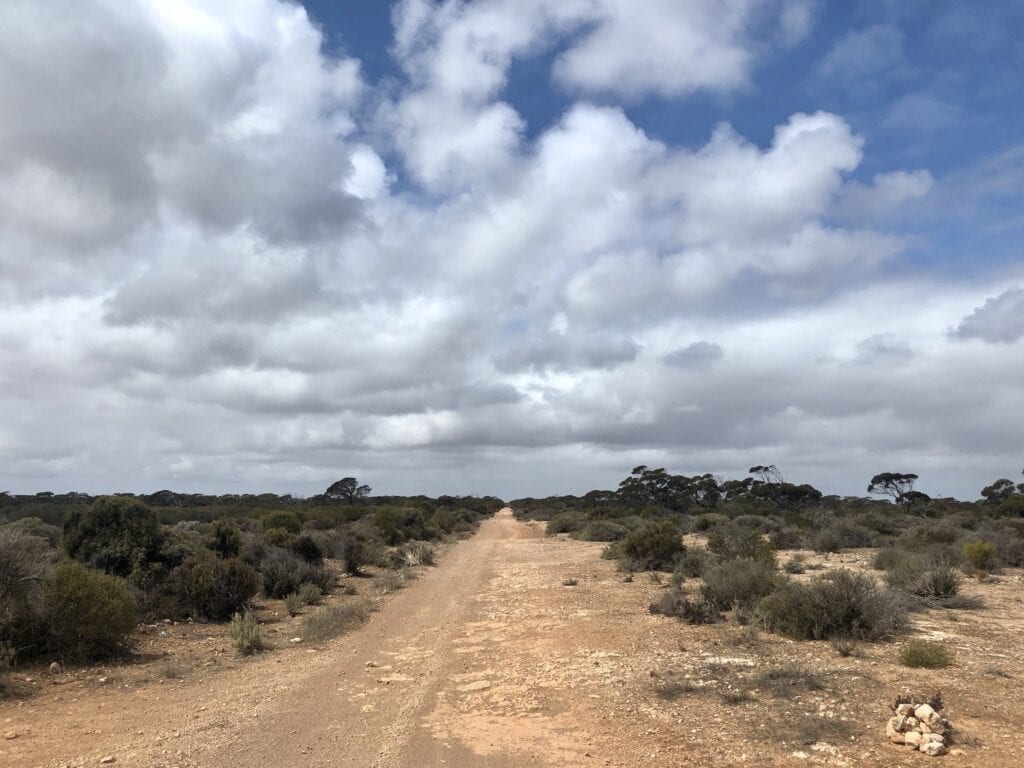
Be aware this is a remote track, even though it’s not that far from the Eyre Highway. Be prepared and preferably carry a satellite phone in case you run into trouble. You’ll need to be entirely self-sufficient.
And don’t even consider this road in the wet or the heat of summer. Caravans? No way! A quality off-road camper trailer will be okay though.
The Old Eyre is like a museum or a time capsule from the fifties and sixties. The occasional car body, plenty of shredded tyres and thousands of old tin cans.
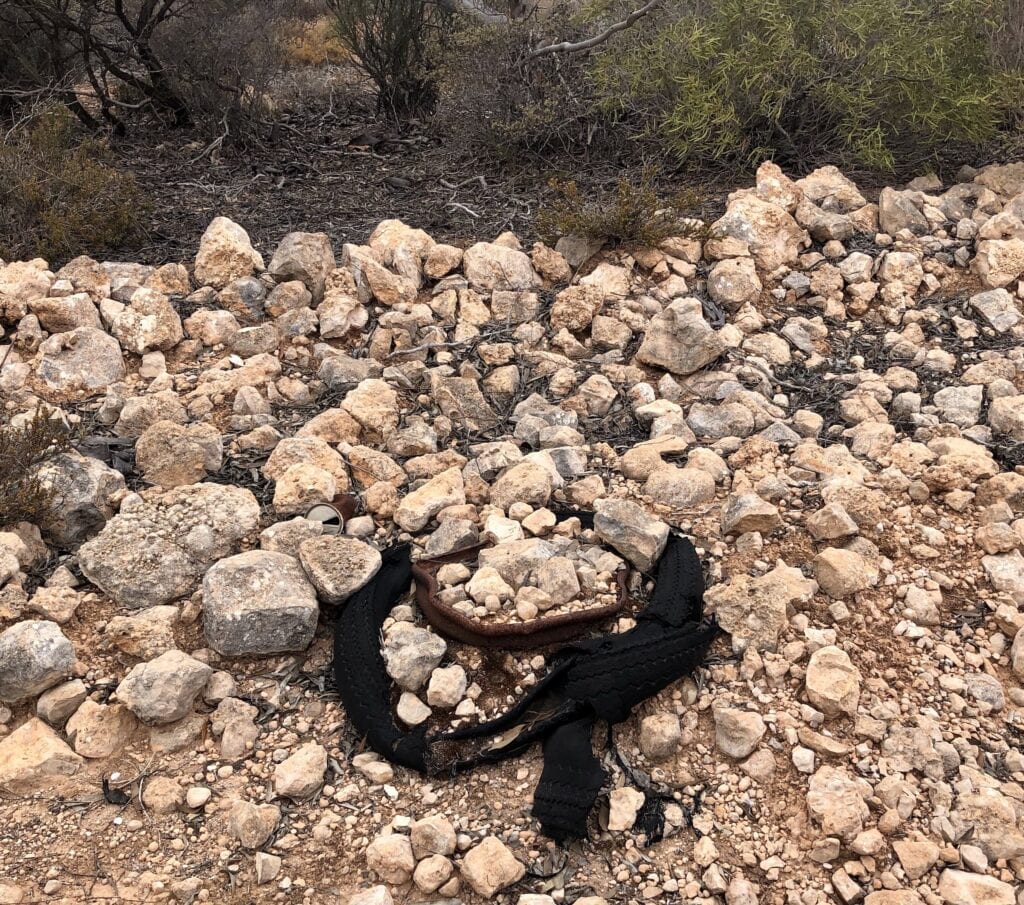
The most popular of these are tin beer cans. It looks like many people drank their way across the Nullarbor! Hardly surprising the Old Eyre was notorious for rollovers…
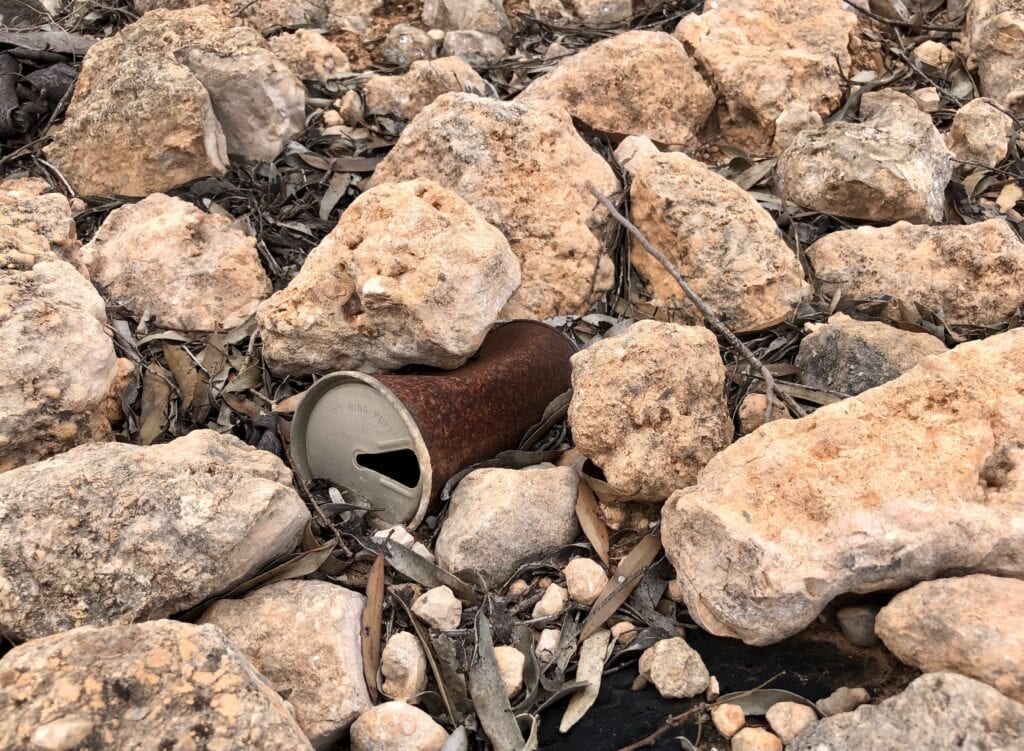
You’ll find old cans everywhere. It looks like people camped by the roadside, had their canned dinner and left their rubbish behind. Some things never change.
And you don’t have to look far to find badly shredded cross-ply tyres and shredded tubes. In fact, you’ll find a bit of everything… mufflers, parts of exhaust pipes, broken rubber bushes. We even found a speedo cable!
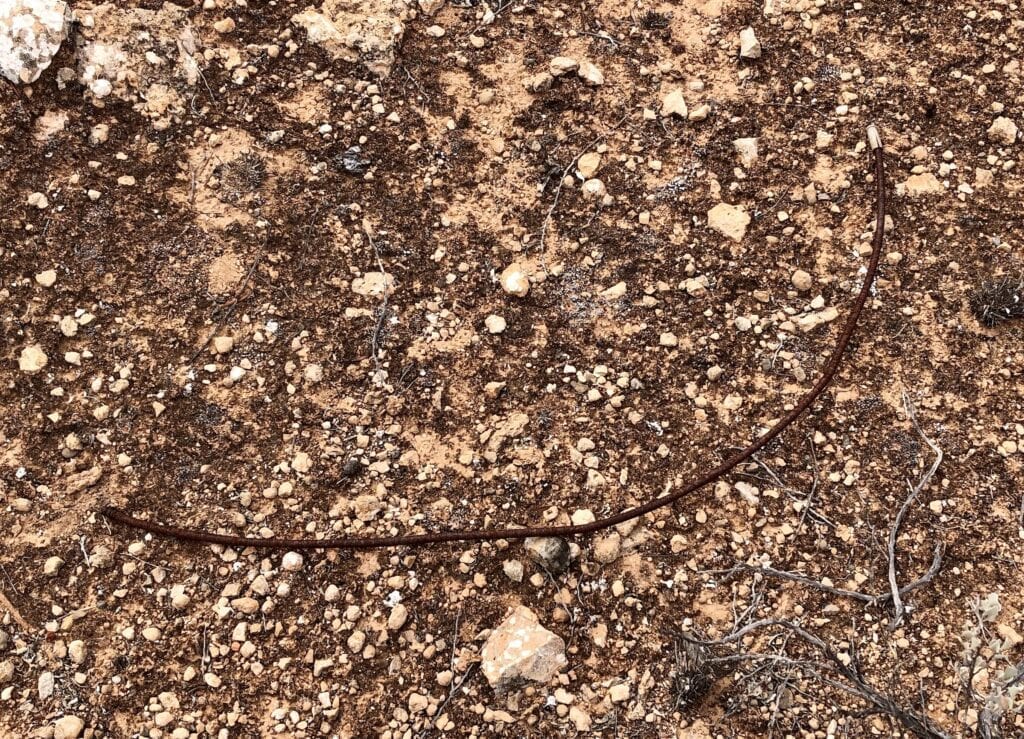
This road must have been hell to drive in its heyday.
We camped on the road, keen to soak up the atmosphere. Like at Koonalda Station, it’s easy to imagine old Holdens and Fords rattling past in a plume of white dust or an overloaded Albion truck lumbering towards you, bellowing angrily at the torture track.
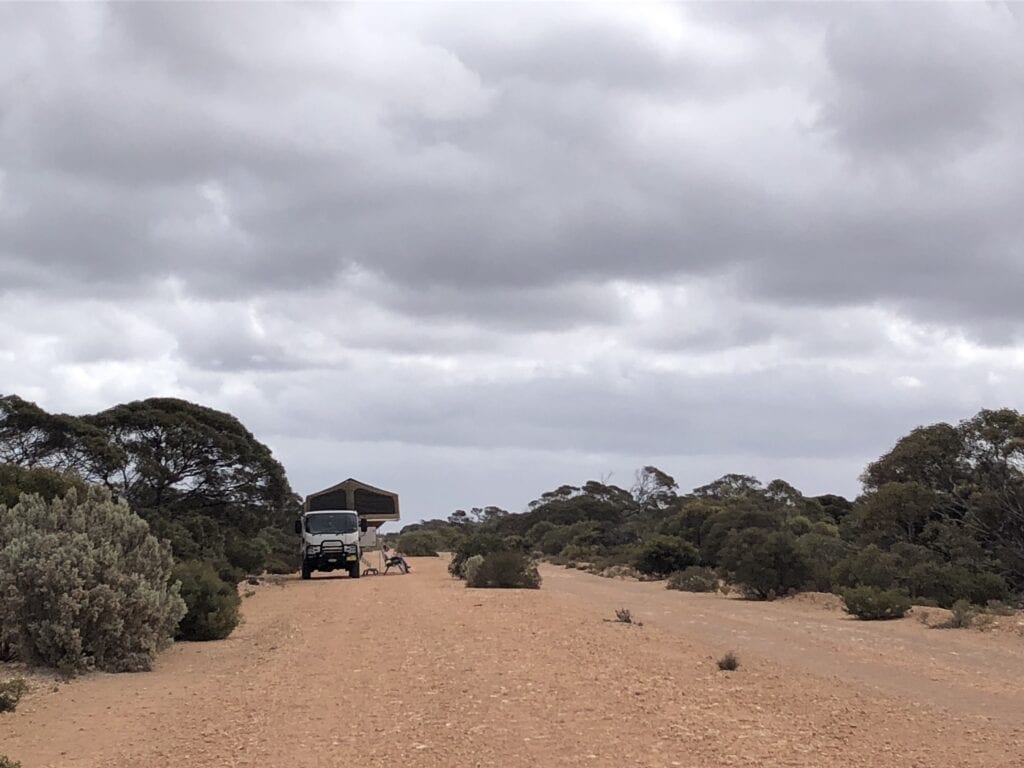
I take my hat off to the truck drivers who did this route. They must have been extremely resourceful bush mechanics and expert tyre repairers.
A Refuge
As we approached Koonalda Station, we could appreciate just how welcome this place would have been to weary travellers. Koonalda couldn’t have come too soon for those low on fuel or down to their last spare tyre.
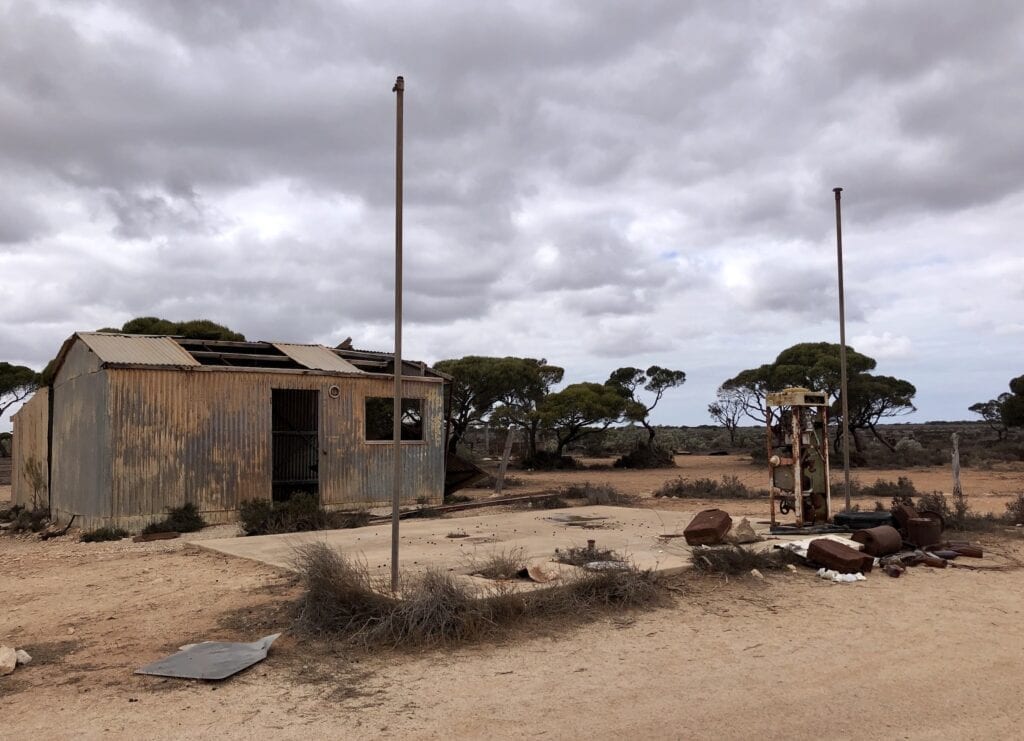
Koonalda Station has been left marooned by the new Eyre Highway further south for many years now. It’s full of ghosts. You can easily see the old cars limping in, broken and desperately in need of repair.
Equally, we wondered how many people drove out from Koonalda, dreading what the Old Eyre was going to throw at them next.
How many anxious people would have been wondering if their battered car would make it to Eucla… or worse, east across the roughest section to Nullarbor Roadhouse?
A Brutal Track
The Old Eyre deteriorates east of Koonalda Station, even now. We were thoroughly spoilt… strong radial tyres, good quality shock absorbers, air conditioning and no vinyl seats to stick to.
Yet it was obvious this part of the road would have been hell on earth. The reefs of limestone across the road get bigger, the long stretches of low-lying boggy sections are still obvious and even now, there’s still a few small patches of bulldust!
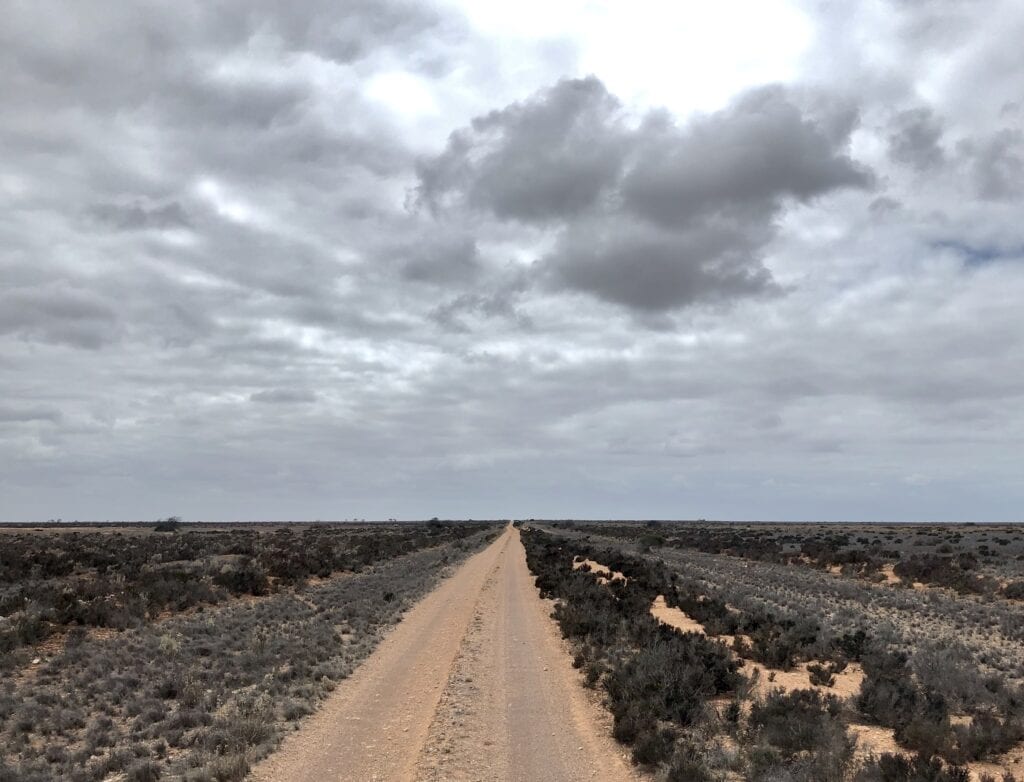
Not only this, but the low trees give way to the open expanse of the Nullarbor proper. Vast expanses of flat, open ground as far as the eye can see. We could only imagine how thick the fine choking white dust would have been.
This was truly a brutal stretch of road.
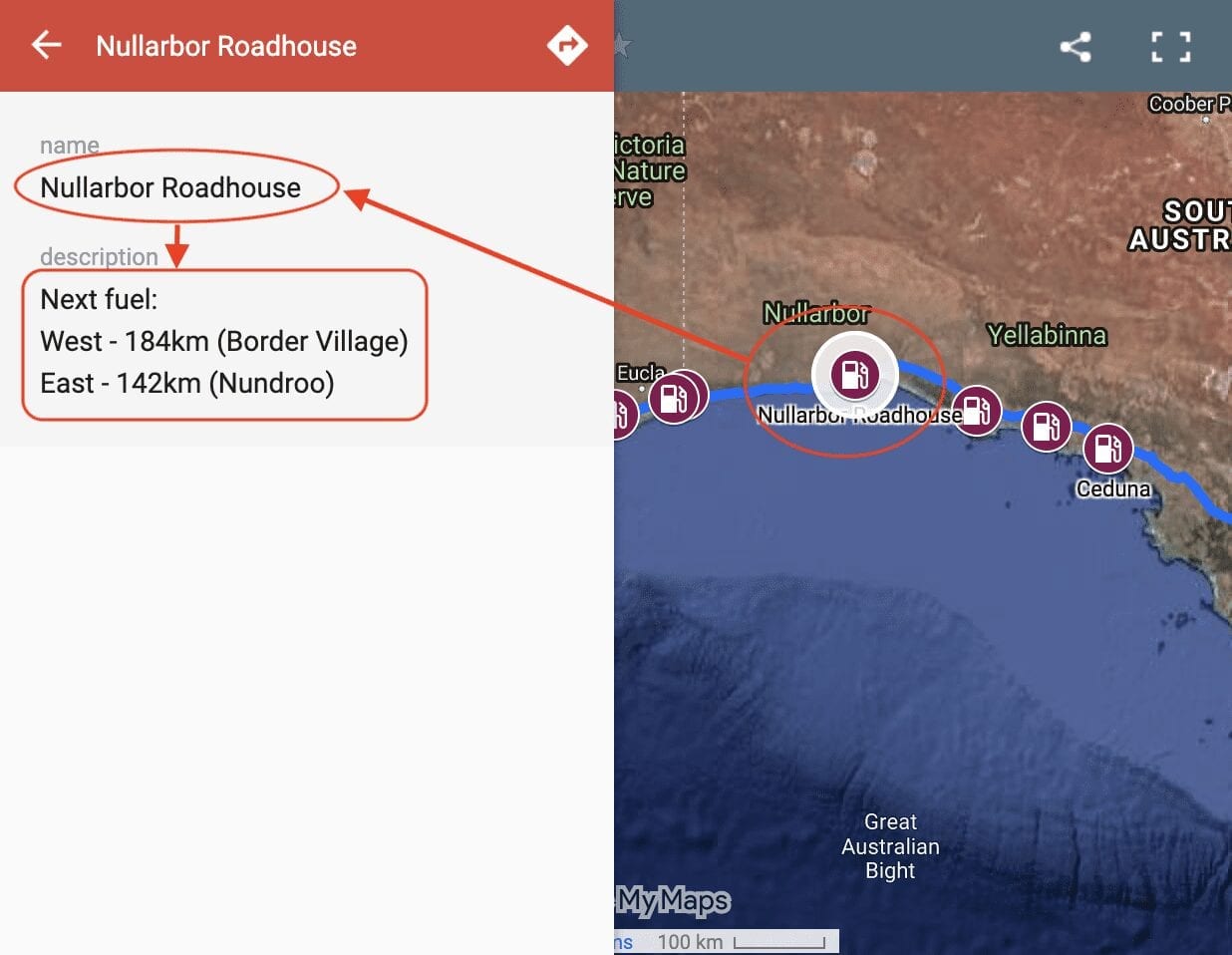
Fuel Stops
So where you can get fuel on the Nullarbor? Our Interactive Map of fuel stops across the Nullarbor will give you all the info you need.
Points of Interest
If you’re thinking this a simply a drive across a bare desert plain, think again. There’s plenty to see along the way.
Holes in the Ground
If you’re into caves, then you’ll love the Old Eyre Highway trip. There’s caves and sinkholes dotted along the road.
Some are right beside the road while others are several kilometres off the road.
Our favourite blowhole was Bunabie Blowhole. This is right beside the road and easily missed. This blowhole disappears deep into the ground and would be a fantastic spot to camp and listen to the blowhole breathing.
According to the Mirning people, this sound is the magic snake Ganba. He thrashes around on the surface and creates dust storms, he drinks the water, eats the trees and eats people. Ganba is the reason why the Nullarbor Plain is as you see it today.
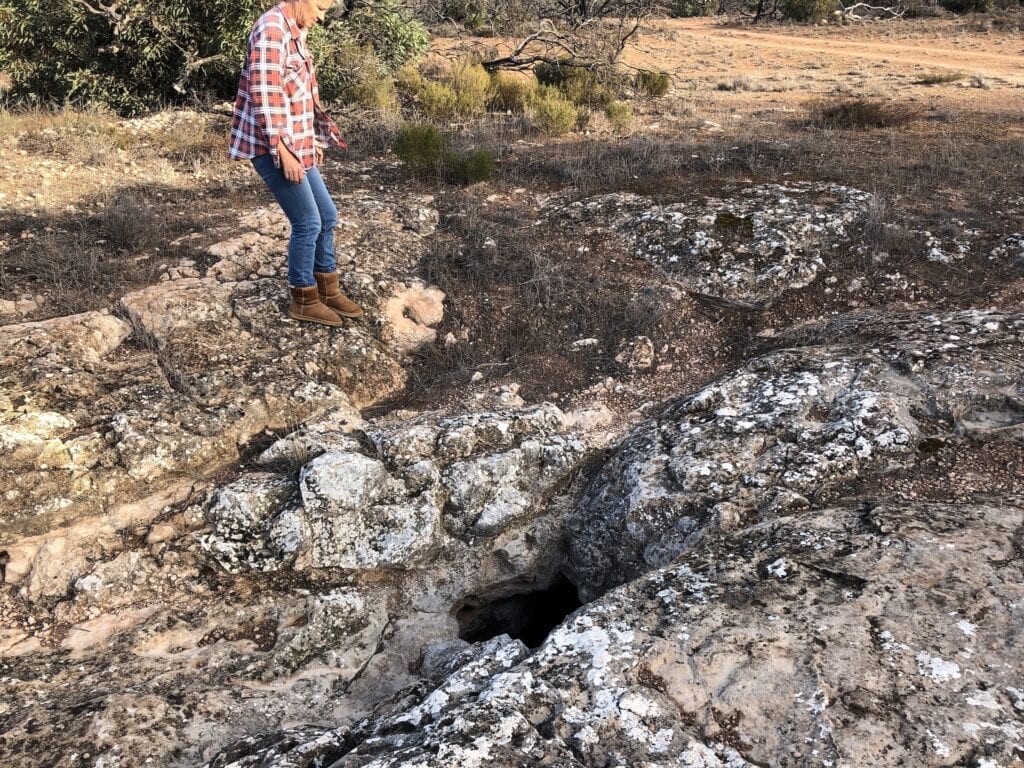
Our favourite cave was Koomooloobooka Cave. As you approach, it looks like a jumble of limestone rocks. When you stop and walk around though, you’ll find several sinkholes.
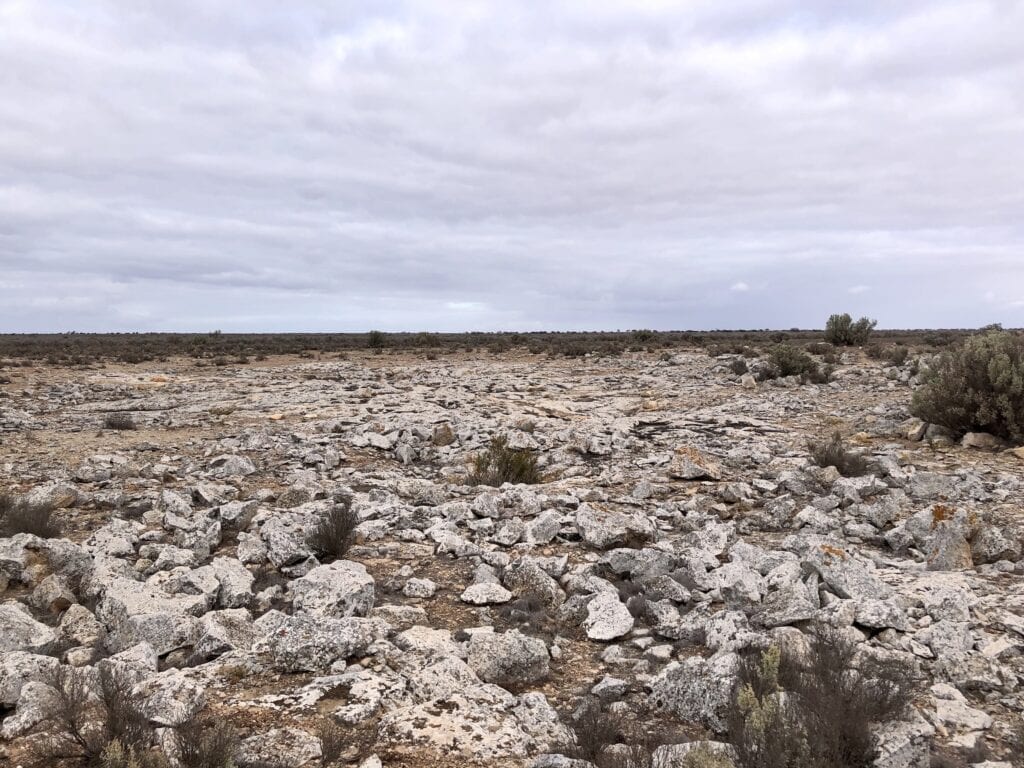
And they’re slightly scary!
Looking down, they open into a large chamber way below your feet. Then it occurred to us… we were walking on the roof of a large underground chamber. By now we were feeling quite a bit less secure, yet fascinated by the view down the sinkholes.
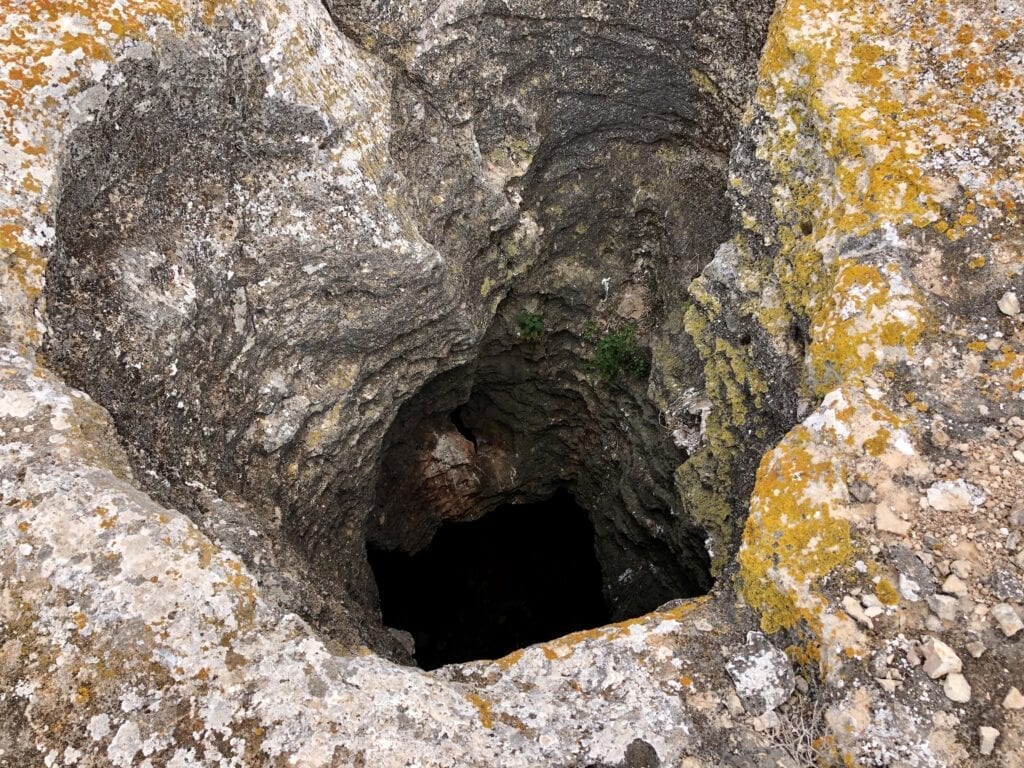
Take care around these sinkholes. It wouldn’t be difficult to slip into one, never to be seen again.
We wondered what secrets these caves hide and completely understood how cavers get hooked on caving. After all, you’re exploring a whole other world down there, an underground world just waiting to be explored.
If you’re not all caved out by the time you reach Koonalda Station, then drive north past the homestead to Koonalda Cave. This cave is enormous and hides a whole other world, closely linked with the First People.
An Unexpected Mine
About 23 km west Of Koonalda Station is an abandoned mineshaft, about 300 metres off the road to the north. On the Hema 4WD Maps app, you’ll see Albala-Karoo Bore on the topo map. If you take this track, you’ll see the mine clearly off to your right. (Go here for Hema 4WD Maps for iOS or here for Hema 4WD Maps for Android).
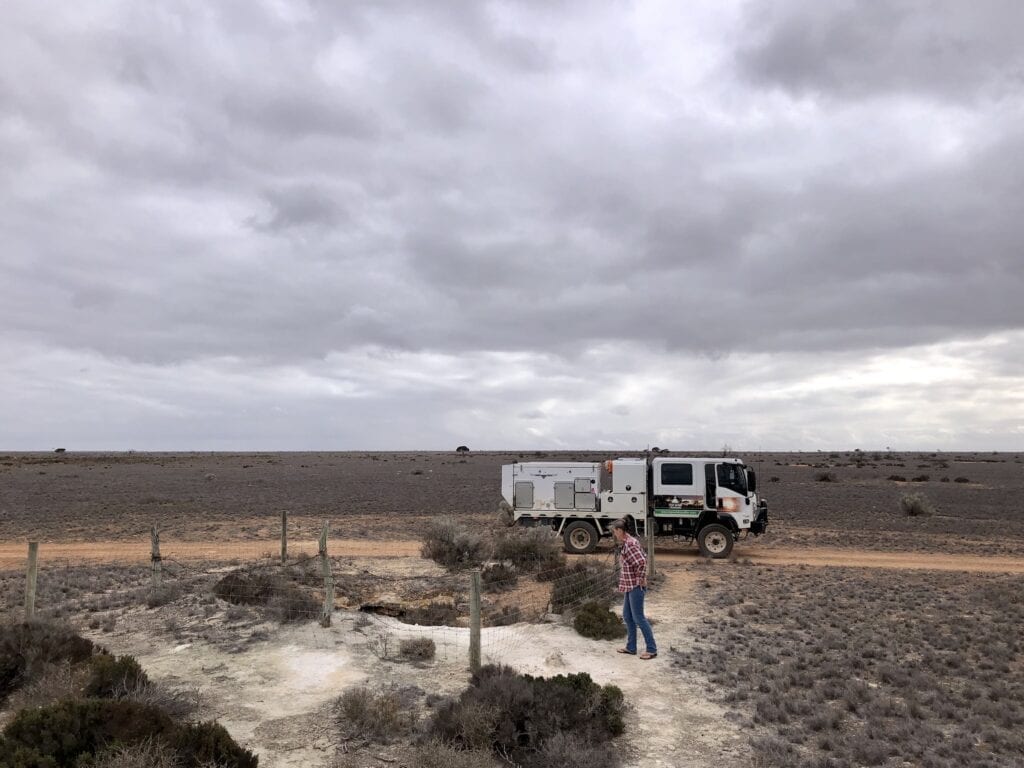
Just what they were looking for we have no idea. How anyone could mine out here by hand in this harsh environment is totally beyond comprehension.
A stone’s throw from the mineshaft is the grave of Herman Johnson who died in 1889. His must be one of the loneliest graves on Earth.
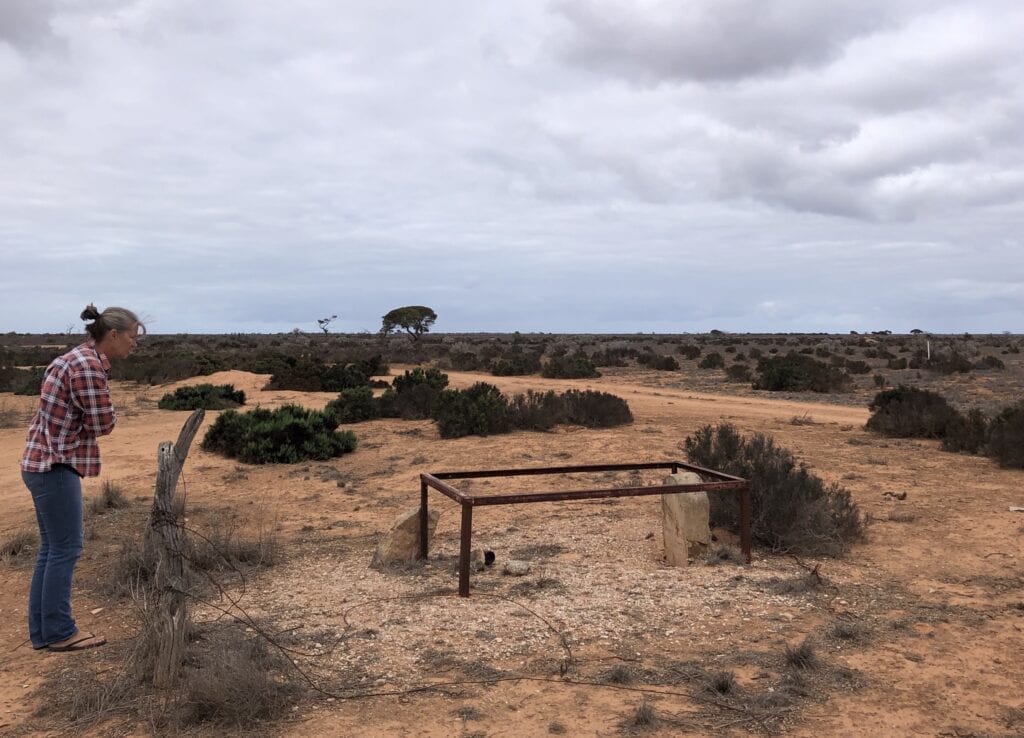
A big thanks to Jane Lett for contacting us and passing on links to details of Herman Johnson. According to accounts on an Eyre Peninsula Family History Facebook group, Johnson was most likely a cook with a Government drilling crew.
They were drilling what is known as Diamond Bore. The diamond drill tip snapped off and remains trapped in the dry bore to this day.
He is variously described as being aged early 20s or 36 and dying of appendicitis or septicaemia. Whatever his true age and cause of death, Mr Johnson died a painful death at a young age… and days away from the nearest doctor.
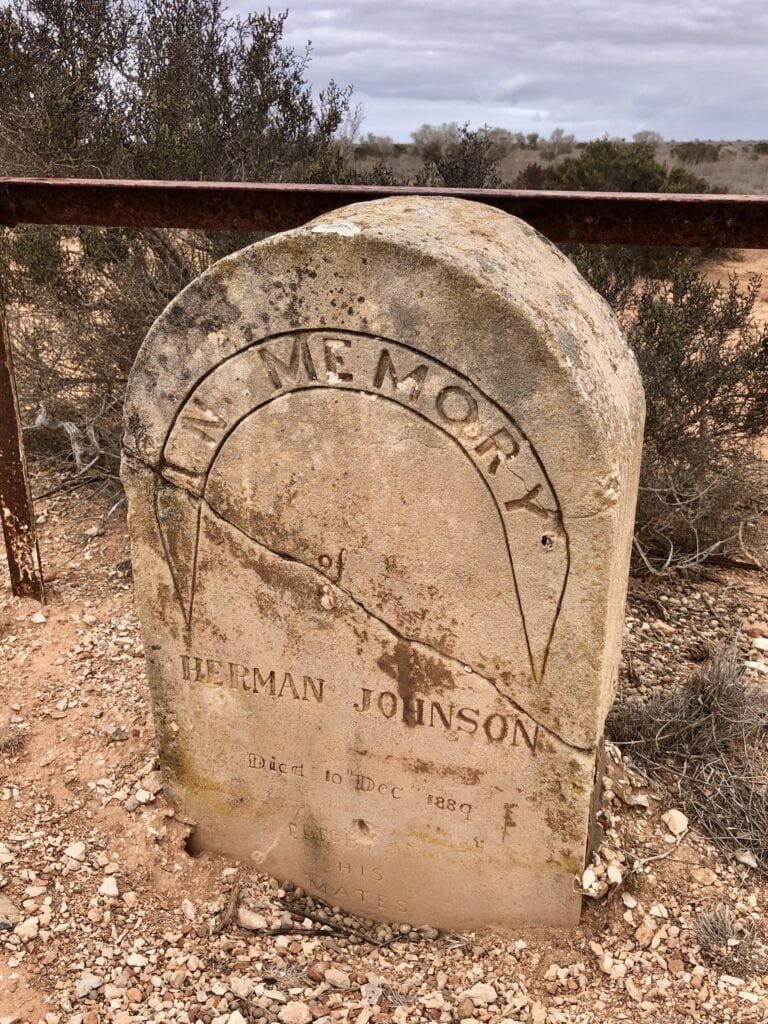
If any of you have more details on Herman Johnson, please send us an email or contact us here.
Cars
You’ll see a few cars on the side of the road, invariably stripped after rolling over.
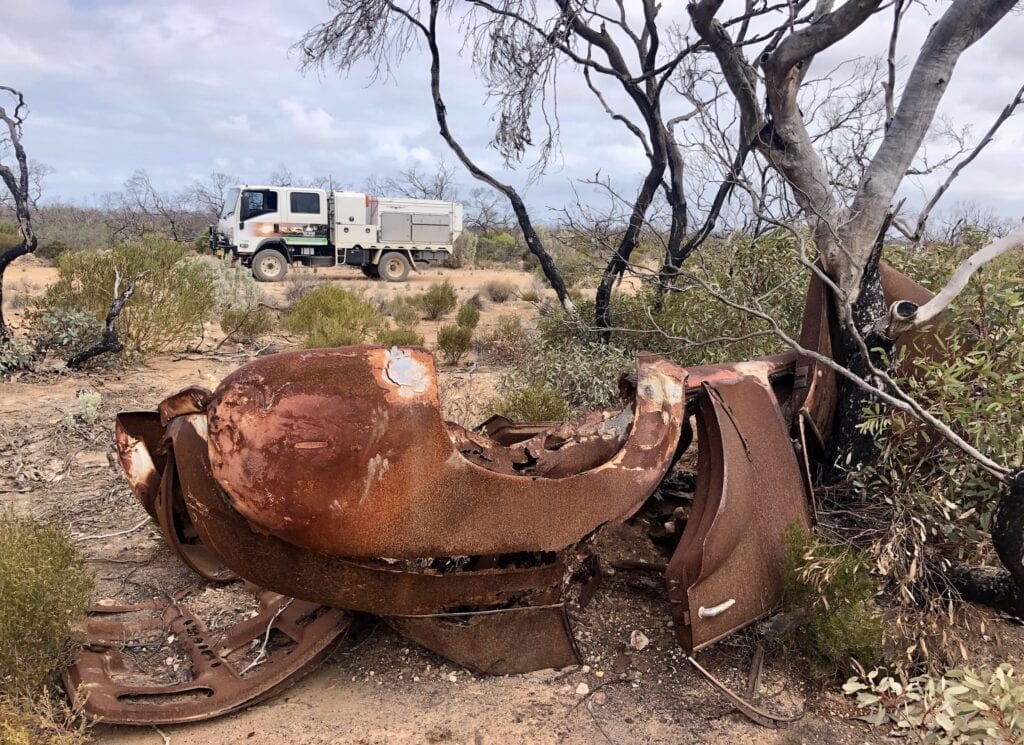
We encountered remnants of an FJ Holden, a mid ’50s American car, a HQ Holden and what looked like a Chrysler Centura on its roof. You’ll continue to see old kerosene tins, oil drums, car and truck tyres and tubes, plus hundreds of miscellaneous bits and pieces fallen off all manner of vehicles.
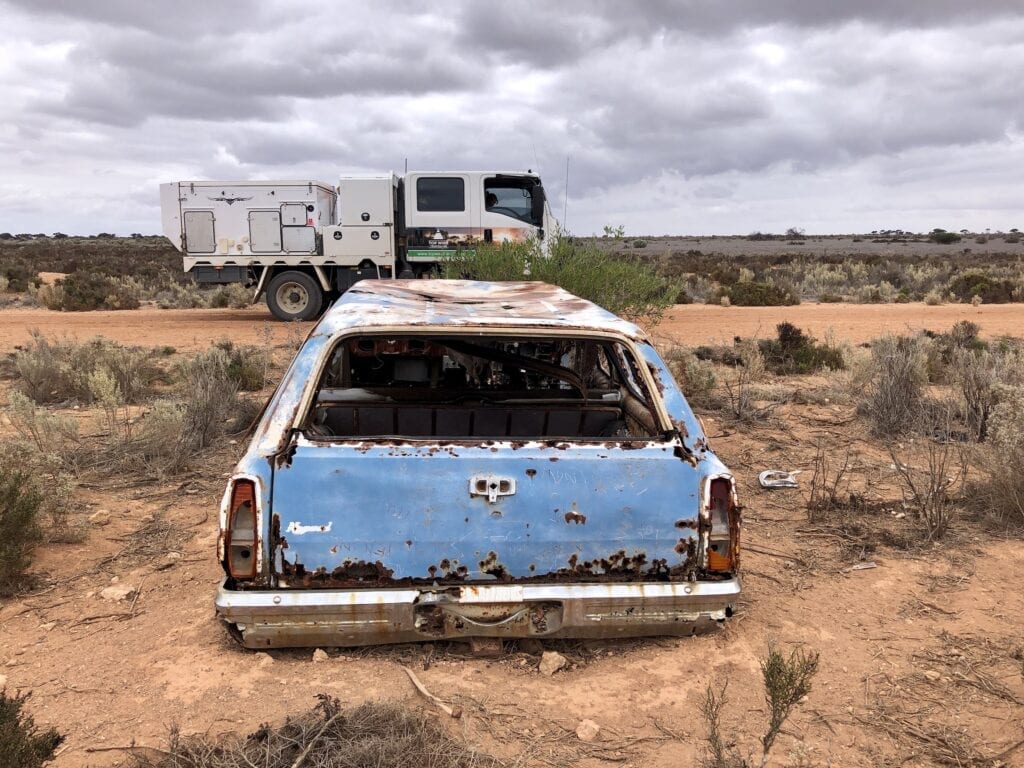
At the intersection of the Old Eyre Highway and the road to Cook, there’s a pile of interesting car and truck parts. It looks like people have collected them and left them there for whatever reason.
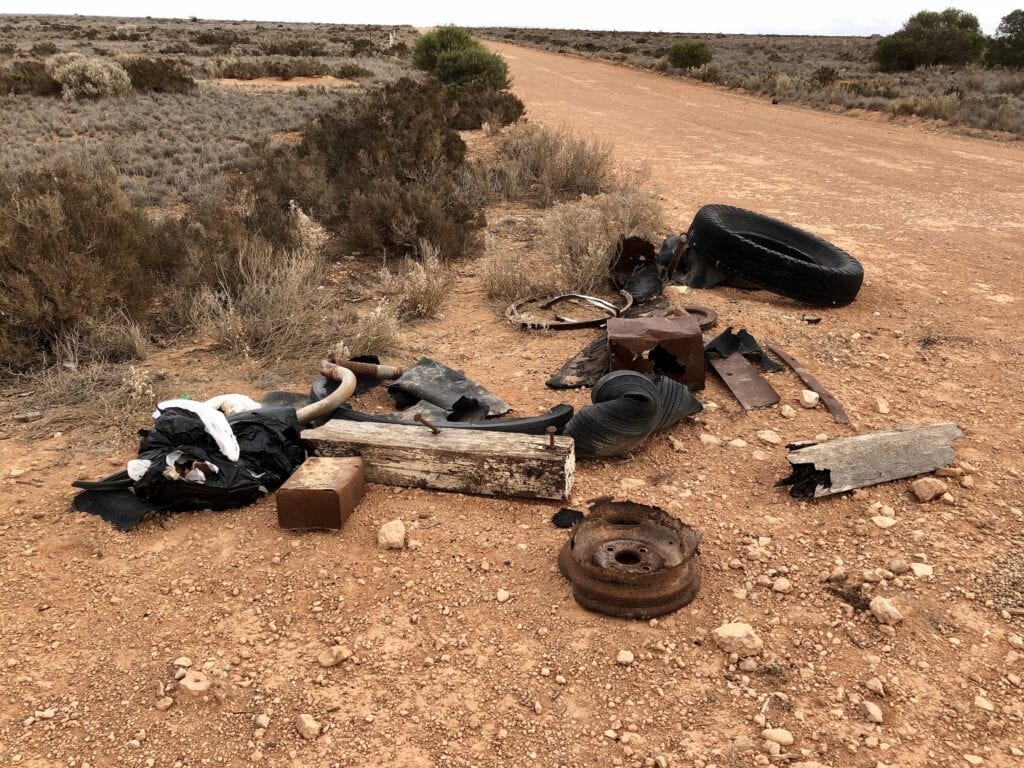
Personally I think they should be left untouched by the side of the road. It’s a bit of history for all to see.
Dingoes and Fences
At the intersection of the Old Eyre and the road to Cook, you’ll see a falling down fence running north-south.
This is the vermin-proof fence. It was originally built as a rabbit-proof fence. However when that plan failed it became a dingo fence to keep dingoes out of the eastern areas.
Now though, this part of the fence is falling over and was obviously abandoned many years ago.
We saw three really healthy looking dingoes along the Old Eyre and a mother with a partly grown pup close to Nullarbor Roadhouse. These highly intelligent creatures are best left alone and you’ll definitely need to stow away any rubbish at night.
The End of the Road
After the Cook road, the Old Eyre Highway becomes quite corrugated. And of course, the ever-present limestone reefs add to the “atmosphere”!
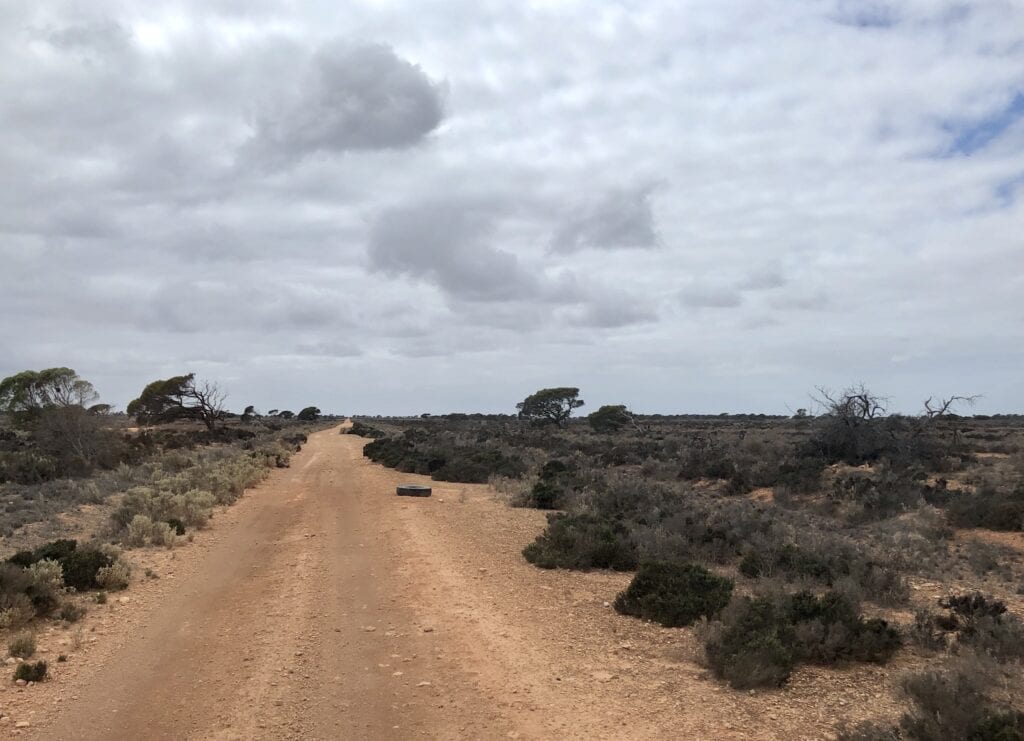
We encountered a heavy shower of rain about 15 kilometres west of Nullarbor Roadhouse. The road instantly turned into a slippery slush, with us going sideways a couple of times.
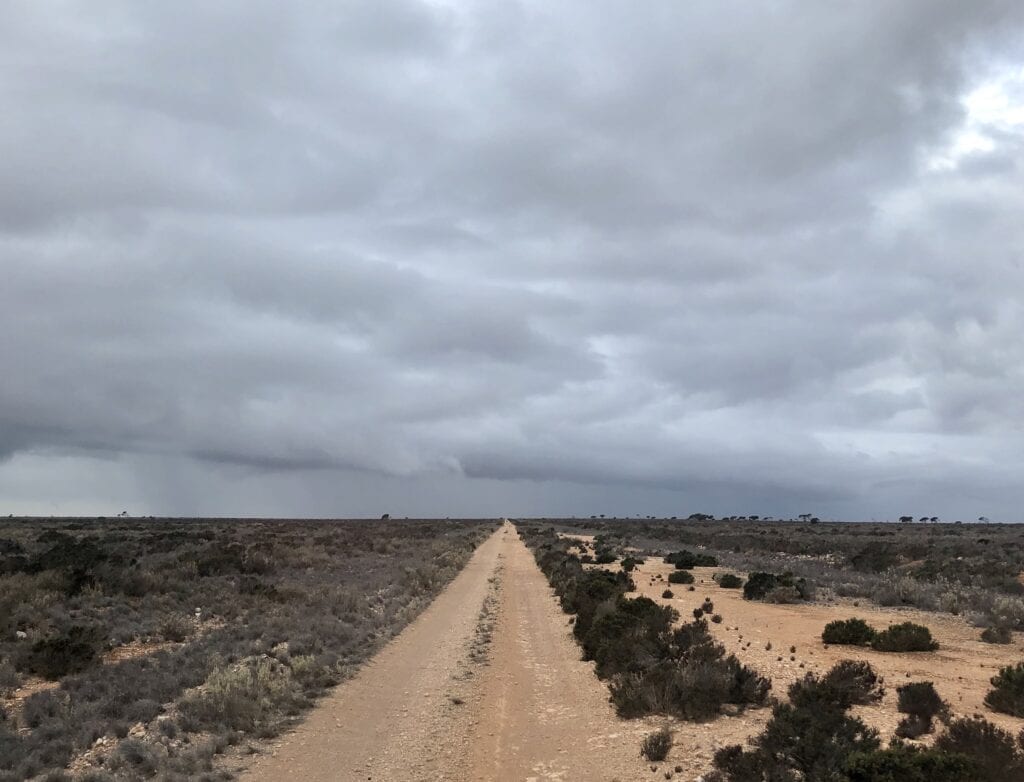
It was a reminder of how treacherous this road would have been in the wet. In fact, it would rapidly become impassable with the slippery clay and deep powdery bulldust holes back then.
There we were in a highly capable 4WD truck, sliding around after one small downpour. Back then though, it would have been 2WD cars and massively overloaded and underpowered trucks with skinny cross-ply tyres.
I had recollections of growing up on a property in the steep mountains of the Southern Tablelands of New South Wales.
Mum behind the wheel of our Valiant up steep clay pinches, expertly guiding the Old Val as we slipped and slid our way to the top… loaded stock trucks caught on steep pinches after a smattering of rain and Dad hooking our beaten-up Land-River to them, trying to help them over the pinch.
As we were driving along, I could almost see the ghosts of the old British trucks labouring through the slush, slewing sideways in the mud, waiting for someone to come along and hook on, trying to tow them through.
Long distance truck driving across the Nullarbor must have been a tough gig.
Finally Nullarbor Roadhouse appeared and soon enough we were driving parallel to the tarred highway. What a contrast!
We were bouncing over the rocks, slushing through the slop while just 50 metres away cars and trucks were thundering past at a comfortable 100km/h.
Upon reaching the Roadhouse, quite a few travellers gave our truck curious glances. They were probably wondering why it was covered in mud from top to tail. If they only knew!
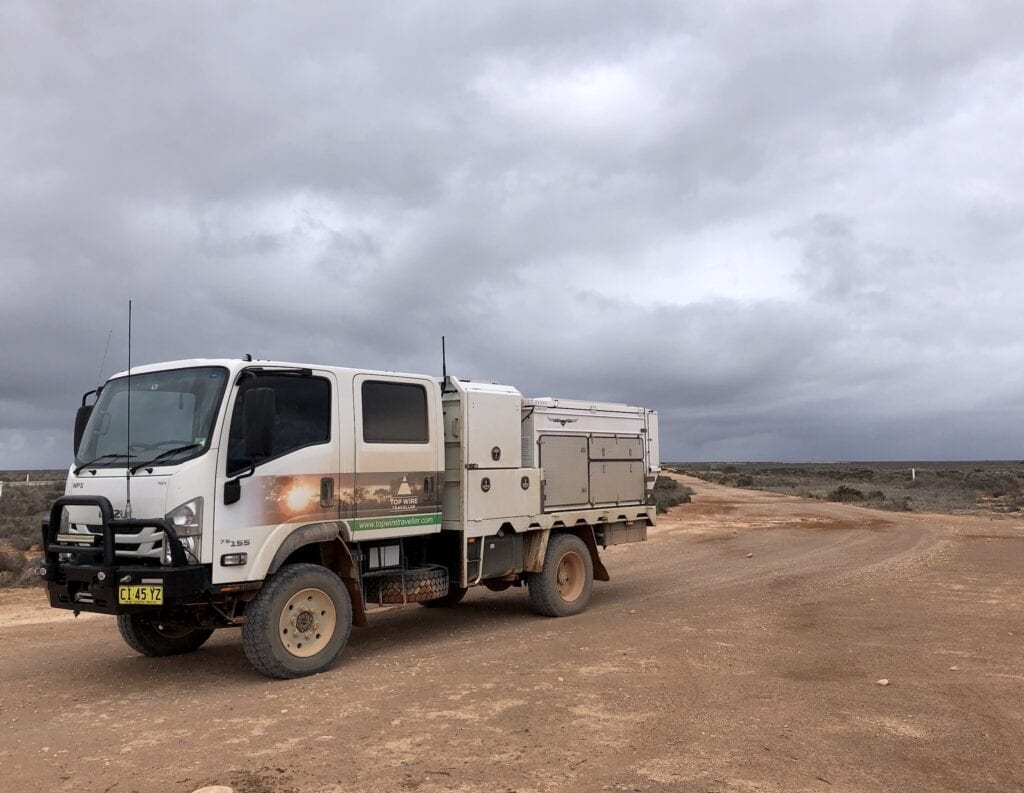
Final Thoughts
So, yes reaching Nullarbor Roadhouse was kind of like crawling out of the Seventies into the present day. It was a world away.
And it was an appropriate way to end the trip.
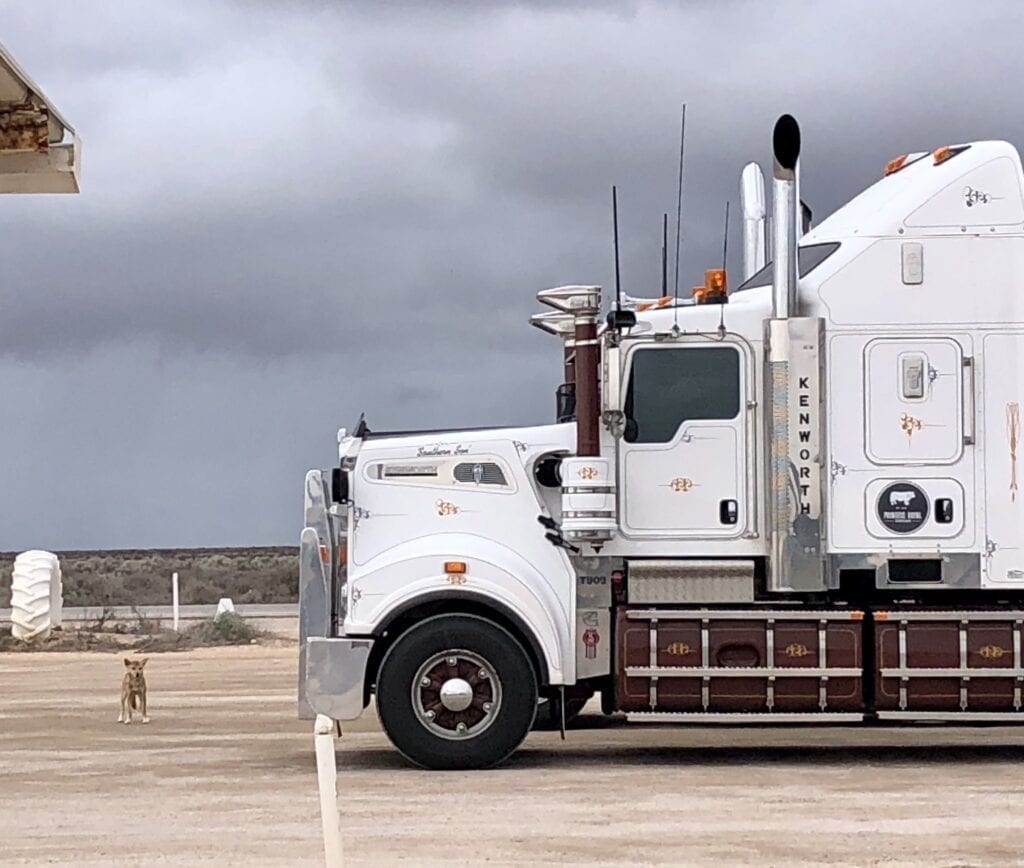
It’s so easy to be immersed in the past as you travel the Old Eyre Highway. You can’t help but be transported back to the days when cars and trucks were unreliable, and roads were no more than an endless ribbon of rough dirt.
How easy it is to imagine these old bangers punching their way through the choking dust. The ghosts of these cars and trucks continue ply the Nullarbor on their endless journey across the continent.
The Old Eyre Highway is on Mirning Country.

Get your Traveller’s Guides
… and a whole lot more at our FREE RESOURCES Page!
Any questions or comments? Go to the Comments below or join us on Pinterest, Facebook or YouTube.
Any errors or omissions are mine alone.
Go here for detailed info on your road trip across the Nullarbor!

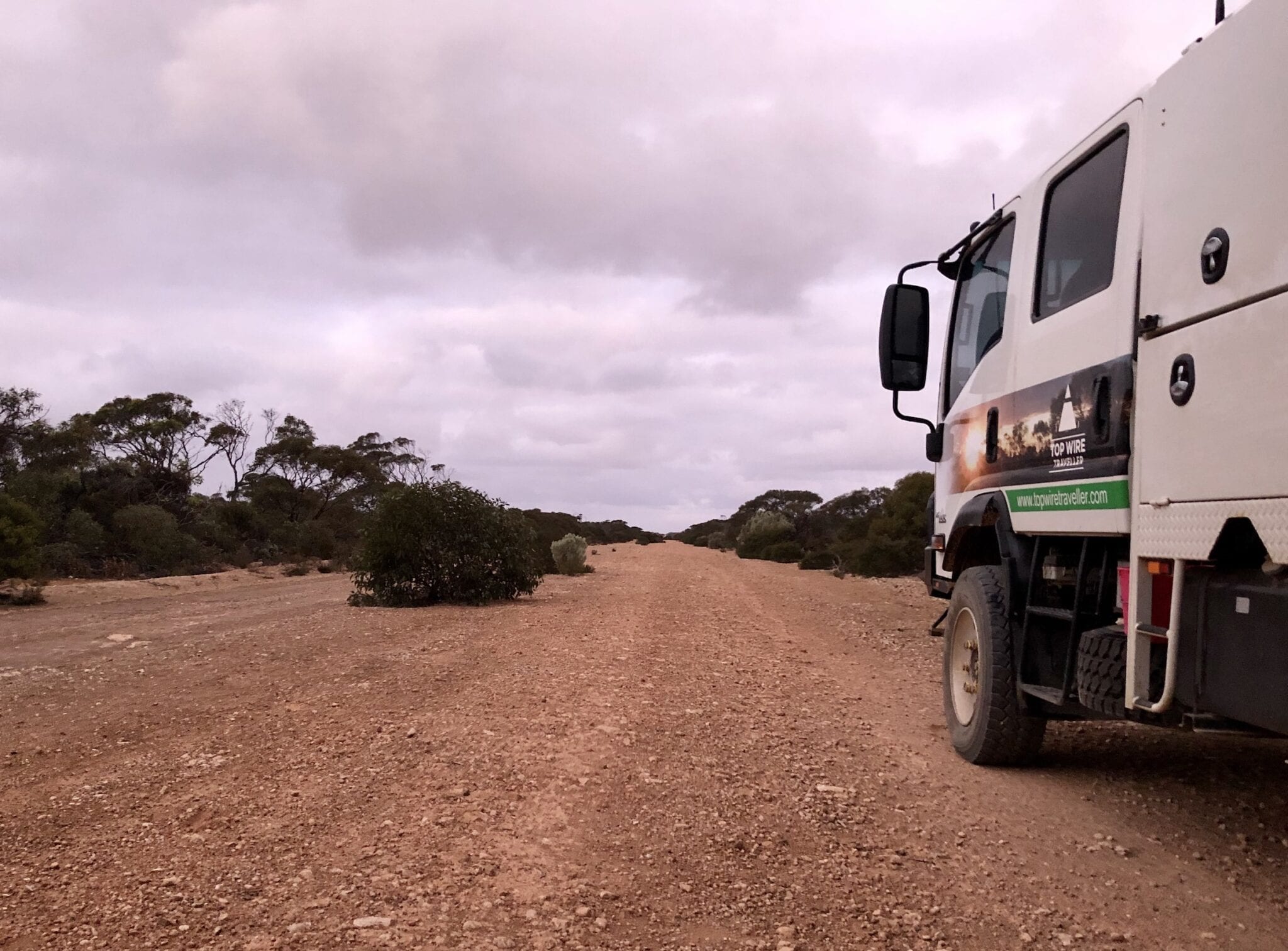
(Note: This is a comment Mick emailed to us. He has some interesting recollections of the Eyre Highway and Nullarbor Roadhouse. Andrew).
Did you note where Ivy Tanks was? That was a pretty good place to get water when others had run out or were running low.
The bitumen was completed on the South Australian side in 1976, prior to the completion of the bitumen, work was being done and sections unrelated to each other were being bituminised. So you could have terrible conditions one minute then a beautiful smooth road for some kilometres. I seem to remember that work on bituminising the remaining dirt sections on the SA side of the Nullarbor plain started in earnest around 1974, I know it was completed in 1976 as I watched the official opening party passing our camp to open it; even though it was open.
You are correct, whenever it rained, traffic just stopped. Mostly people just camped alongside their vehicles, or slept in them. The best part was the wind, it dried out the road quickly, but it was usually biting cold.
People often camped near tanks if possible, with many doing repairs of some sort before the light faded.
Fuel at Nullarbor station was around 1 km from the road and pretty much alongside the station house, whereas today, the road house at Nullarbor is on the highway pretty much where the cattle grid at the station entrance used to be.
Ivy Tanks is between Nullarbor Roadhouse and Yalata. Unfortunately, this part of the Old Eyre Highway is no longer accessible to the public. After doing some research, it looks like Ivy Tanks was indeed a popular stopping point for travellers.
Ivy Tanks was an interesting place with sharks and other fish life pickled in jars and on display as well as business cards form those passing through. They were almost the wallpaper. I travelled that initially in 1968 when we went east to compete in a Rothmans Car Rally out of Sydney. When the decision came to move to Sydney I was 6 months pregnant with my 5th child and my husband went ahead by plane and train while I packed up the house and the children, sold my rally car and purchase a Ford Fairmont wagon and set off with 4 kids, a dog, ca and a bird and drove through to Sydney. I then drove back to Perth in early December to give birth. The next time I made the trip my 6th was born in the back of the car at Eucla but I pushed on to Perth where the news made the front page of the West Australia relegating the footy Grand Final to the back page and since then have travelled that road 21 times by myself with the kids although the last time I did it was in Chrstimas 1979 and I had 8 kids on board and did the Sydney/Perth trip in 52 hours. Spent 4 days in Perth and returned to Sydney. That trip was all bitumen by then and it was much better that circling the bull dust that one always had to be careful of because if you hit a patch and went in hard you broke the front end. It was great for the kids growing up as they got to see what a huge country we live in
Hi Carol,
Thanks for adding your recollections, they’re fantastic. You would know the road like the back of your hand! I can just picture a carload of kids in the Fairmont, sticking to the vinyl seats in the summer.
Cheers, Andrew
Drove from Melbourne to Perth and back again in june 1972 in a EK Holden stationwagon
Great trip with no problems
Three guys slept in the car
I’m jealous, that would have been a brilliant trip! Cheers, Andrew
My parents travelled from Stockport in South Australia to Perth in 1934 in a 1929 Chevrolet ute. Family photos show the ute with two spare tyres, the dog and all their possessions under a tarpaulin in the back. The road then wasn’t the “old Eyre Highway” but across the Nullarbor was the maintenance track for the Overland Telegraph line.
I travelled the wartime built “old” Eyre Highway in both directions at the age of 8 with my father and older sister in 1948 in our 1939 Chev sedan, travelling back to South Australia following the death of my grandfather. We spent the first night at Balladonia where I remember – without the slightest understanding of the problems involved – my father removing the fuel tank and soldering a leak it had developed before leaving the next morning in the dark. He was a farmer and to my mind just took these things in his stride. My sister was only 11 so my father did all the driving and I marvel at his stamina as I look back now. I recall we camped the second night at the Ivy Shed Tanks – as the RAC guide named them – and Kimba the third night with friends on Buckleboo Station. We slept in shearer’s quarters at Balladonia and I don’t recall any sort of motel accommodation on the road at all.
The second time I drove the old Eyre Highway – I can’t recall now what we called it then but it certainly wasn’t the Eyre Highway – was in 1960. Three 19 year old uni students drove across during the Christmas holidays in a 1957 VW beetle to a student conference in Adelaide. We took out the back seat and the third person slept on our swags and some blankets in the back. I recall how grateful we were for the German door seals which kept out the dust in a way no British car ever could and the way the flat bottom of the beetle seemed to float us over the long patches of bulldust. My memory is that the bulldust, and the condition of the road generally, was much worse than when I had travelled the road only 11 years earlier.
I’ve not driven the “new” Eyre Highway but I feel I should one day just to complete the family’s history with the road.
Hi Graeme,
Fantastic stories, thanks for sharing. You’d certainly find the trip very different now, with a good tarred road all the way across.
Cheers, Andrew
Loved this story. In November 1965 my wife .and I packed everything we owned, including our cat, in our 1961 VW beetle and set out from Fremantle to Wagga Wagga. We did not know it at the time but my wife was pregnant (what a Christmas present for me). From recall it was bitumen to Balladonia then unsealed until we hit the bitumen again somewhere near Penong. The VW did not miss a beat with those lovely 16 inch wheels taking on those corrugations while the 13 inch wheels on the EH Holdens felt every one. At some place we came across a near new Viscount caravan where the entire ceiling and wall had collapsed, a total mess. One memory is trying to pick the best rack on a road that on some places was about 50 metres (ok yards in those days) wide. Nearly came to grief near Ivy Tanks when a car coming the other way was using the same track as me. My wife, who kept track of finances calculated it cost us £29 ($58) in fuel to make the trip; for our next trip (Melbourne to Perth) we will budget at least $1000 each way. We have done the trans-Australia road trip at least 20 times now, but the main memory is that first one. Nowadays it is just a long, long drive, not an adventure.
Hi Idris,
A fascinating story, thanks for sharing. Those bigger 16″ wheels would have made a big difference to the VW’s ride. It’s interesting how you remember the road being so wide in some places. We noticed this just west of Nullarbor Roadhouse. I can only imagine how rough it would have been.
Cheers, Andrew
Hi great read very informative…we’re doing this in about a months time..We last traveled on this in 1974..in an Austin 1800…
This time we’re traveling in our 4×4 Isuzu NP300 motorhome…
Cheers.l
Hi Marilyn,
Glad you enjoyed the article!
An Austin 1800 vs an Isuzu NPS motorhome… that’s a big step up!
You’ll love the trip, especially if you already did it in 1974. Enjoy!
Cheers, Andrew
Having a touch of nostalgia. I drove with 2 chums in December 1967. I had been in Australia since August 1964, in Sydney and Broken Hill. I met Margaret Bourke, Maitland, in BH in 1966 and Flora MacPherson, Perth, Scotland in BH in 1967. We travelled to Perth WA for our trip and came back to BH in January. I found our recently that the road I drove was ‘The Old Eyre Highway’. I’m not old. I went with my husband and 3 children for a month in July-August and reached the Barrier Reef and Uluru because they wanted to see these special places. I’ll keep your article in ‘Favourites’ and look from time to time.
Hi Margaret,
That would have been an epic trip in 1967! Thanks for sharing your memories with us.
Cheers, Andrew
You are one amazing lady,! Great memories for your family. Well done.
Just one fond memory of many and after completing 5 trips in total over 5 years. After moving to Perth by ship and not road from Penrith N.S.W. in 1965 with my parents and two sisters it was decided to return to N.S.W. for a holiday in 1967.So we embarked on the return trip in an FC holden station wagon and my grand father in his FB ute complete with home made canopy. Every thing was going well untill we reached Ivy Tanks were it was discovered that the head on the FB had cracked an loosing water. My father being a holden mechanic and carrying almost a spare car on the roof racks set about repairing the head.It took them several hours but they got the job done by closing the crack with a centre punch and lock tight (kind of a body filler)The head was supposed to have been changed in Port Augusta but my Grand father being an old bushy left the head on the car and was still holding together for another couple of years.What great memories
P.S.have just completed the Nullabor with my Wife for the first time since those years with just a few minor changes. What a Road.
Hi Graham,
Thanks for sharing your memories. Those old Holdens were much easier to work on than modern cars! And fixing a cracked head with a centre punch and Loctite has to rate pretty highly as a bush fix… very clever.
Cheers, Andrew
Hi,
The first time i travelled the Nullarbor was in April 1972 with my father and three siblings and took turns with dad at driving.
From Nullarbor station i took over driving every two hours and every time i drove the grader had just graded the road so it was quite a smooth drive.
When my dad took over he copped the ungraded sections (apparently that’s the way they graded the road), in sections.
I have travelled back and fourth, Perth to Sydney and vice versa now 15 or 16 times and i am doing it again in Jan 22 to meet my daughter and grandkids in port Augusta for a week and then travel back via the old Eyre Highway.
There are some amazing stories here and they have brought memories back to me i had forgotten
Thank you all
Hi Alan,
Thanks for sharing your experiences of the Nullarbor. And I agree, the stories and memories in these Comments are fantastic. Keep them coming everyone!
Cheers, Andrew
Wow sounds like my family time back then too! My dad was an interstate truck driver who took me as a kid all the time on the Sydney to Perth run, they were such happy carefree days back then and loved every minute of it! My Mum got a job at the only servo on the Nullarbor and us 3 kids stayed with her there for the 12 mths when my Dad started the Adelaide to Perth run too, and there was a little tiny zoo in the back of the property and aborigines in loin cloths coming to buy bread! Lol sadly my dad died in a truck accident when I was 10
Anyway cheers
I discovered this site when my younger brother started driving to Queensland via the Birdsville Track with his partner and three children. They got a puncture and had to stay at the Birdsville hotel overnight. It reminded me of the time when our family went to to visit my mothers brother in Perth in 1972 via the old track, my brother was a baby then.
It started me thinking what happened to the old road so I googled Ivy Tanks and found your site and so glad I did as it brought back so many precious memories reading everyone’s experience.
We departed Adelaide in a big American Biscayne Chevy, Dad, Mum and Grandad in The front (drivers) and Nanna in the back on one side with the baby bassinet at her feet, three kids on the other side and one in the wheel well on a rotation basis to prevent arguments and one on the parcel shelf, 10 humans in all. We lost our exhaust pipe early on in the trip, the car sounded like a army tank the whole journey, many punctures including one at Ivy Tanks. We travelled through a bush fire on the way to Perth and a flood on our way back to Adelaide.
My parents have passed now but I am so grateful for their adventurous spirit. It has been one of the most significant experiences in my life and I will never forget it. Thank you for rekindling those memories.
Hi Jody,
Thanks for adding your story here. I too love reading these stories of people’s adventures across the Old Eyre Hwy. It must have been an epic trip.
I love your story about the 10 humans, it’s a classic!
Cheers, Andrew
Thank you for sharing, i have just come back from a trip out there, i have crossed the Nullabor many times, but always in a hurry to get to the west. This time i spent time having a look around and loved it, the history is great. Until now i thought a blowhole was by the sea with water coming up through it, i now know that you can have a blowhole without the water, if you can take the time you can hear the wind coming up from underground.
Safe travels Bob
https://bobcaddell.com/html/books.html
Hi Bob,
Yes, it’s a brilliant trip. And you’re correct, those blowholes are pretty weird!
Cheers, Andrew
TERRY RYAN
i traveled, ha ha survived, the old Nullabore track in the spring of 1971
the south Australian side 800 miles of bare earth and muddy, my old 1965 Valiant and my home made caravan made it, But progress was very slow, 15 to 20 miles an hour doging pot holes bigger the your swimming pool, The West Australian side was gravel corrogated gravel AND DRY, i fitted light truck tyres to 15inch wheels to both rigs and carried 6 jerry cans of fuel, i never saw any other caravan until i got to the wa border, They were doing a u turn after being warned by police not to continue. BIT DIFFERENT TO 2022 when you see thousands of caravans, driving the black top.
A great story Terry, thanks for sharing. And you’re right, it’s a whole different world now.
Cheers, Andrew
I lived at Colona Station which was a part of the Yalata Ing Community from 1964-1967 as a young kid. What a great time we had. Dad was the Station manager, we ran approx 10,000 sheep. Use to travel to old Ooldea the original community, down to the old dog fence beach. Travelled to the Head of the Bight. Lots of great fun.
cheers Gaye
Hi Gaye,
Thanks for sharing, so many people like yourself have shared your recollections of life along the Old Eyre. What a fantastic life for a young kid!
Cheers, Andrew
Hi Gaye just looking up now after 50 yrs I work for main roads department from cyguna to eucla in 1966 I was actually drove the bitumen truck to open western Australia border so many memories especially at eucla RGDS Wayne from Adelaide N b best time of my life
Back in the depression my grandpa and a friend left Port Hedland in WA on push bikes. They travelled down south turning east and crossing the Nullarbor and then onto Ballarat in VIC for a job. It took them both 16 weeks to complete the trip and all for a job. They certainly don’t breed them like they used to.
Wow, that’s an epic trip in a car let alone on push bikes! And most of the journey would have be dirt/sand. Thanks for sharing, the world’s a vastly different place now. Cheers, Andrew
HI Joel I an currently doing some work on an exhibition of cyclists that crossed the nullarbor. This will be a formal exhibition by the WA Historial Cycle Club on for 4 months (from Oct 2023 in the MUSEUM OF PERTH. Would you and family have any information? I would include the info as an anecdote….do you know what brand of bikes they rode? If you wish to participate just send me an email and I will take it rom there and perhaps talk some more
Thanks Joel
In 1965 as £10 ‘pommie bastards’ two of us travelled from Perth across the unsealed Nullabor Plain in a 1956 VW combi. What I remember most were the ever present miles upon miles of severe corrugations and the red bull dust that managed to find its way into every little place inside the combi! The thin copper pipes connecting our two bottled gas containers on the front of the combi to our little fridge and gas hob inside were always splitting. I don’t remember how many times we broke down and how often the windscreen was shattered by passing lorries! Finding drinking water was once or twice getting a bit critical too.
Hi Brenda,
Thanks for your vivid description, I felt like I was sitting between you two in the front seat!
Cheers, Andrew
My wife and two girls aged 3&2 drove a HT Monaro from Melbourne to Perth in 1973. Ivy Tanks was a great site for filling up (although expensive) during the trip. I remember the owner asking me if we wanted to stay the night, as it was getting late. On inspection of his accommodation I declined and drove on. The rooms were constructed out of VW boxes, that brought Volkswagens into Perth. I would gather a bit of speed on the dirt road and then BANG, a pothole covered in dust was taking chunks out of my tyres. We counted 22 cars and trucks abandoned on the road that had broken down, rolled or caught fire. Made it across and back in 2 weeks with only chunks out of the rear tyres. Drove into my driveway at home to spot my jack sitting in the garage floor that I had forgotten to put back in the boot. ( Very Lucky)
Thanks for sharing your story Eric. You were lucky with the jack! Cheers, Andrew
Very interesting finding this site. I had a friend (he passed away early June 2021), who back in the late 1960’s used to drive his 1954 Leyland Octopus truck from Castlemaine VIC to Port Hedland WA, traversing the Nullabor multiple times. He often told me about Ivy Tanks as a rest and fuel stop. I have his photos of those days. He also told me how the old English trucks of those days were built with scarcely any regard to the drivers comfort or welfare. Red hot temperatures in the cabins, constant vibration and noise. Those guys sure earnt their pay. Watching ill-prepared travellers in totally unsuitable vehicles in all sorts of trouble was all part of the journey.
Hi Ian,
That’s a long way, especially in a Leyland Octopus! He would have had some incredible stories to tell, I’m sure. Cheers, Andrew
My first trip from Melbourne to Perth to Port Hedland and back in 1975 was by Yamaha XS650 .The bike ran very well no dramas except the muffler lost its internals somewhere along the way so got a little noisy.The dirt and corrugations made it very interesting but found riding on the opposite side of the road a bit smoother for those bits.I have looked out the photo’s for that trip and found a travellers village hotel motel which i didn’t write on where it was,has anyone doing that trip around that time seen that motel?
In May 1965 I was transferred from Northam Main Roads to Kalgoorlie, on arrival in Kalgoorlie, the Divisional Engineer informed me that my job was to go out the Eyre Highway and complete the construction. I was on site in one of the two construction camps until around April 1967 when I went to live in Kalgoorlie. I commuted to the construction by light aircraft and car apart from 3 months living on site in charge of construction of Madura Pass from September 1967 to Christmas 1967. I organised the celebrating of the completion on the WA side on 17th October 1969. The event was attended by the then Federal Minister for Transport Billy McMahon and his wife Sonya, The WA Premier David Brand the WA Minister for Transport, Commissioners of road authorities of WA and SA, Shire of Boulder and Dundas Presidents approximately 70 guests. I also attended the SA celebration on 1974 with the then WA Minister for Police Ray O’Connor
Thanks for sharing your story Ian. First-hand accounts of life on the Eyre/Old Eyre are brilliant and bring the past to life. Cheers, Andrew
Hi Ian just read your comments!!!! We may have seen each other on the nullourbor??? I got the job at MRDept Kalgoorlie there I started at caiguna to the opening of the WA border I started in 1966 I was driving the tar baby in the bitumen gang so many good memories working 23 days straight then 7 off our tin sheds were out great homes with no insulation but we adapted to the experience I’m still remembering those days today especially comming from Sth Australia in a ford counsel in that famous bull dust RGDS Wayne
I have just rediscovered these Ivy Tanks photos and stories and takes me back to 1974. Me and 3 other Kiwis were travelling to W.A. to drive tractors for seeding season (it was late April). We arrived in Sydney and then had to get to Perth by 1 May. We all pitched in and bought an EK Holden car and headed off to Perth. After about a 1000 miles someone said have we got a jack etc. Nope so stopped at a wreckers for one. We each drove 100 miles and then swapped drivers, We had 2 cans of beer and enough petrol in the tank to get from one petrol station to the next. I have a photo of Ivy Tanks. We did 8 weeks about 150 miles north of Perth then drove all the way back and up through Broken Hill. The car never missed a beat. We had to replace the universals in the drive shaft on the farm otherwise just put petrol in it.
A fantastic story Ian, especially the part about the jack! Thanks for sharing. Cheers.